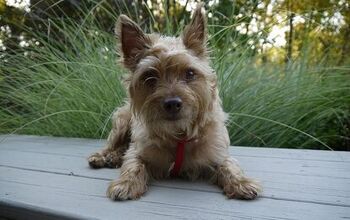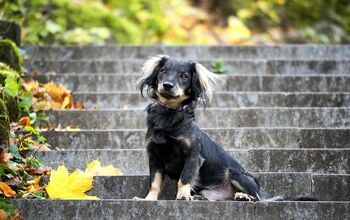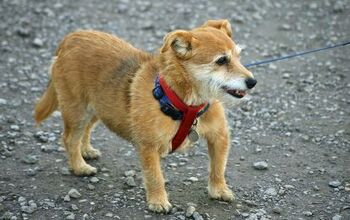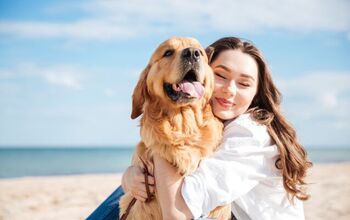Bernedoodle


About Bernedoodle
We are committed to finding, researching, and recommending the best products. We earn commissions from purchases you make using the retail links in our product reviews. Learn more about how this works.
Bernedoodle Basics
If you are looking for a smart and loyal dog that will be your companion for life, look no further than the Bernedoodle. Also known as the Bernese Mountain Poo, this breed is a combination of the Bernese Mountain Dog and the Poodle. These hybrid fluffy pooches combine the best of both worlds: the intelligence and low shedding coat of the Poodle combined with the laid-back, yet incredibly loyal nature of the Bernese. For anyone who has owned either of those breeds, you’ll know that means that the Bernedoodle is one special pup, who combines the best traits of both parents into one cute package!
The goal with crossbreeding these two popular dogs was to create a perfect companion for families of all shapes and sizes that will be both hypoallergenic and possess personality traits that make them ideal pets. That’s why the breeders didn’t stop at first generation mixes, but continued to select and perfect Bernedoodles in different sizes and with slightly different traits. Bernedoodles can vary widely depending on the breeder as there is no set standard for this breed (which is usually the case with all designer dogs). They can range from 10 to 50 pounds in size and can have quite different personalities from wildly energetic to a more stoic and calm demeanor. A lot will depend on which of the parental breeds' genes are more dominant in the mix and whose traits are going to be more apparent – the Poodle’s or the Bernese Mountain Dog’s. Luckily, this also means that there really is a Bernedoodle for every person and it’s hard not to fall in love once these special dogs enter your life.
However, while Bernedoodle should ideally be a perfect mix of the parent breeds that only features the best of both worlds, with hybrids there is no guarantee either about their personality or their looks. In a litter of fluffy little Bernese Mountain Poos, all of the puppies might look different from each other and each one of them could have a wildly different temperament as well. For example, your Bernedoodle puppy might take after its Poodle parent more and be a furry brainiac that will learn tricks with ease and have an air of elegance to them. Or they might favor their Swiss ancestry and turn out a bit more stubborn than you’d expect, but with a heart of gold that will make it impossible to get mad at their antics. It’s hard for breeder’s to predict with this tricky hybrid, since there’s no proven “recipe” on how to ensure which breed gets to be more dominant in the mix. On top of the fact that you can’t predict their personality or looks with certainty, depending on the dog’s genetic makeup, they can have health issues more typical for one breed than the other.
Related: 10 Best Harnesses For Bernedoodles
Although there’s still a lot to learn about designer dog breeds, it’s safe to say that we now have a better picture about the Bernedoodle as these hybrid mixes have been around for quite a while now. Their name may sound a little funny, but these dogs make wonderful pets, and they are especially great with children, so they are often the first choice for families with young kids. There’s a reason why this designer breed has grown in popularity so rapidly. These are truly special pups. So, if you are looking for a fluffy dog that will be your companion for life, look no further than the Bernedoodle!
Origin
Most designer dogs have quite a mysterious origin story that’s difficult to pin down, but that’s not the case with the Bernedoodle. Hybrid dogs have been in existence for many years, so the first crossing of a Bernese Mountain Dog and a Poodle may have occurred long ago. We can’t really say if and when the first accidental cross between these two breeds could have produced a mixed breed litter of puppies! Nevertheless, what interests us the most is when this mix became a product of deliberate breeding efforts. The breeder who claims to have been the first to intentionally breed Bernedoodles is Sherry Rupke of SwissRidge Kennels. Rupke bred her first litter of two Bernedoodles in 2003 and has since developed a regimented breeding program around this hybrid breed with great success. It’s been almost two decades since the first litter of these designer dogs was born, but they still remain one of the most popular doodle mixes around – and once you learn more about Bernedoodles, their unwavering popularity doesn’t come as a surprise. The family tree of the adorable Bernese Mountain Dog and Poodle mix speaks volume about its qualities. This is a special dog composed of some of the finest breeds around. Anyone seeking out a Bernedoodle can look forward to one of the finest designer dogs ever bred.
Related: 10 Best Leashes For Bernedoodles
The main breeding processes includes Bernese and Poodles of all sizes, but Rupke added Australian Labradoodle to her lines to create the Australian Bernedoodle. This particular type of pooch is created by crossing a Bernese Mountain Dog with the Australian Labradoodle, which is another hybrid breed (a blend of Labrador Retriever, Cocker Spaniel, Irish Water Spaniel and Poodle).
Pedigree
The Bernedoodle is a 50/50 mix of a purebred Bernese Mountain Doodle and a purebred Poodle. This combination is called the F1 Bernedoodle (or a first generation cross). It is believed that these puppies grow up to be much healthier than both of their parent breeds and that they display the most desirable mix of traits from both. But, first generation mixes also happen to be the most unpredictable type of designer dogs – there really is no way to determine how the litter will turn out and which parent will they favor more.
However, it is possible to have a Bernedoodle with more or less than 50 percent of each parent breed in its heritage if a first-generation Bernedoodle is mated with either a Poodle or a Bernese Mountain Dog. F1b puppies are most likely to be low shedders and as a result, they’re the best match for owners who suffer from dog allergies. For this type, a Bernedoodle is bred with a Poodle, so the Bernese genes are diluted to 25 percent, whereas the non-shedding Poodle gets a 75 percent stake in the F1b Bernedoodle’s ancestry. It’s all in the genes, as they say.
Related: 10 Best Toys For Bernedoodles
The F2 puppies are not as coveted as their parents; the second generation is a product of an F1 Bernedoodle crossed with another F1 Bernedoodle. While you can expect more consistency and predictability with F2 litters, these puppies might be more affected by the health issues of their purebred ancestors. Additionally, F2 Bernedoodles tend to have less attractive coats. As always, careful breeding strategy is necessary to produce the best results from any designer dog. This is one of many reasons why it is crucial to go for a reputable, responsible designer dog breeder who will take great care to select and produce healthy dogs – and know the processes needed to achieve certain characteristics.
Bernedoodles are playful and affectionate – they do well with children and they love to spend time with their families.
Food/Diet
Bernedoodles are no different than any other dog around – they need a high-quality, balanced, and healthy diet to stay happy and healthy. The primary ingredient of the food you pick, whether dry or wet, should be real meat, followed by complex carbs, healthy fats, and a variety of minerals and vitamins. Most dog owners decided on kibble with the occasional wet food treat meal, as it is the most convenient option, but after consulting with your vet, you could also opt for raw or home-cooked diets.
In addition to ingredients, you should also pay attention to other facts, such as if the formula you choose is appropriate for your pet’s size, activity levels, and age. While your pooch is still in the puppy stages of their life, it’s best to opt for foods that are formulated for your Bernedoodle’s size. Toy and mini Bernedoodles should be offered dog foods formulated for small-breed dogs, while your standard Bernedoodle should be fed a large-breed recipe. Toy and mini Bernedoodles should be offered a dog food formulated for small-breed dogs, while the standard Bernedoodle should be fed a large-breed formula.
Related: 10 Best Collars For Bernedoodles
Training
When they are still young, some Bernedoodles can be a little bit headstrong or overly energetic. This is particularly true of the toy and mini versions of Bernedoodles. For this reason, it is important that you start your Bernedoodle puppy with socialization and training early. You have a smaller window to train them properly than some other breeds.
If bred well, a Bernese Mountain Poo should be an easily trainable dog. This beautiful breed itinherits intelligence, eagerness to pleas, and calm demeanor from its parents. However, expecting that every single dog of this hybrid breed to have an ideal temperament is not something that’s realistic. More often than not, Bernedoodle puppies are not that different than most other fur babies. This means you need to be prepared for a bit of mischief and more than a few ups and downs before you can consider them fully trained! Patience is necessary with these pups.
In some cases, these adorable and fluffy puppies can be a bit more stubborn than your average doggo. It’s during those delicate puppy years when this trait will be the most pronounced. It usually goes away once your dog grows up and goes through all of the stages of training. This headstrong quality comes from the Bernese Mountain Dog line, so Bernedoodle crosses with less of this breed may not have this problem. It depends on the specific animal.
Related: 10 Best Bowls For Bernedoodles
Nevertheless, even if takes a bit more effort-basic training and socialization are a must. Without it, your puppy could grow up to have difficult behavioral issues. Start with the essentials, such as potty training and teaching your Bernedoodle puppy how to walk on a leash. Introducing them to children and other pets is also recommended, as it will give you the opportunity to steer them in the direction of desirable behavior in future situations. Lastly, if your puppy shows promise and seems to favor the Poodle mom or dad more, you can consider moving up to more “complex” training options. Teaching fun tricks or training for agility could be the energy outlet your pet needs. It will also serve to deepen the bond between you, so there are many important benefits to proper training.
Weight
Bernedoodles are a cross between the Bernese Mountain Dog and the Poodle. Because the Poodle comes in three different sizes, so does the Bernedoodle. A toy or a tiny Bernedoodle stands 12 to 17 inches tall and weighs 10 to 24 lbs. A mini Bernedoodle stands 18 to 22 inches tall and weighs 25 to 49 lbs. A standard Bernedoodle stands 23 to 29 inches tall and weighs 70 to 90 lbs. There’s a Bernedoodle that can fit into any home. It all comes down to careful breeding.
Temperament/Behavior
Because the Bernedoodle is a combination of two different breeds, the puppies will have a combination of personality traits from each parent breed. How much of each personality will appear in your Bernedoodle depends entirely on the amount of each breed that is involved in the cross. It can even depend on the individual pooch. Littermates that have the same parents might turn out to favor different lineages, with some leaning more towards their Poodle or Bernese roots than others. However, for the most part, Bernedoodles are known as a well-rounded, playful, and affectionate breed. They do well with children and they love to spend time with their families. These are quite affectionate and loyal animals, regardless of which of their parents they take more of their personality from.
From the Bernese Mountain Dog side, Bernedoodles can be a little wary around strangers so early socialization is important. Toy and mini Bernedoodles also tend to be more energetic and stubborn than standard Bernedoodles. One thing to be wary of with this breed is that they need a lot of human interaction, so they shouldn’t be left alone for long periods of time. This also means that separation anxiety could end up being a problem for Bernedoodles. It all comes down to whether or not they are not properly socialized on time. Because of this, it might be smart to start crate training them while they’re quite young. Teaching them that a crate could be their little safe space while you’re away at work could help them feel more calm and relaxed whenever you’re not at home.
On the other hand, Bernedoodles need to be around their owners is a part of their appeal. This indicates that these cute fluffy pooches are as friendly and affectionate as they come! They inherit fierce loyalty from Bernese Mountain Dogs, who are known to form incredible bonds with their families. Your new puppy will likely be the same: they’ll get attached to you in no time and act like a typical “velcro dog.”
Common Health Problems
For the most part, the Bernedoodle is a healthy breed. In fact, the creators behind this designer breed claim that elimination of health issues typical for the purebred dogs is what drove them to crossbreed dogs in the first place. Bernedoodle breeders also claim that F1 puppies, which are 50 percent Poodle and 50 Percent Bernese, are least likely to display serious hereditary health issues. The same should hold true for the Australian Bernedoodle, as its gene pool is even more diverse than the standard Bernese Mountain Poo’s.
The fact that their gene pool is much larger is one of the reasons why, in many cases, crossbred dogs are less likely to develop congenital conditions than purebred dogs. That is not to say that the Bernedoodle isn’t prone to developing certain conditions because all breeds have the potential to be affected by a number of different diseases. Some of the conditions that may affect the Bernedoodle include hip dysplasia, eye problems, skin problems, and elbow dysplasia. Additionally, different types of Bernedoodle have different health concerns. For example, the F1b Bernedoodle or the tiny Bernedoodle could be at more risk of developing digestive diseases and immune system diseases due to their higher percentage of Poodle genes. Similarly, issues with bones can often pester dogs who take after their Bernese parent.
Reputable Bernedoodle breeders will do genetic testing on both the parents and their litters to ensure their puppies don’t have a predisposition to certain hereditary diseases. However, in no scenario is it possible for someone to predict how healthy any dog will be throughout their entire life. The best you can hope for is that a proper diet, plenty of exercise and regular visits to the vet will help keep your pooch healthy and happy. Also, remember that all dogs are susceptible to health issues, even those who are bred carefully to avoid them. That’s just how life goes for any living creature, even pups.
Life Expectancy
As Bernedoodle is still a new breed which is still being perfected, there is not enough information about their lifespan. While there is no way to say with certainty how long Bernedoodles live, breeders estimate that the average life expectancy of a Bernedoodle is between 12 and 15 years. Of course, there are bound to be slight variations due to the difference in sizes, so a tiny Bernedoodle might live to be 17 years old, while the standard sized are closer to the shorter end of the range. It’s going to take a few more generations of Bernedoodles to get a better sense of the average life expectancy, but for now 12 to 15 years is a reasonable guess.
Exercise Requirements
The activity level of Bernedoodles varies depending on breeding, but they are typically a moderately active breed. They do love their outdoor adventures and will be more than happy to join you on a hike or your morning jog. But they do not need intensive exercise to stay healthy and happy if you mobility is limited. With that being said, the Bernedoodle does make a good choice for apartment dwellers, provided that they have enough space and if the owners are willing to take their pet on long walks and to the dog park.
Keep in mind that these are not working dogs and they are specifically bred to be easygoing companions. This means that Bernedoodles can adapt to various lifestyles, including the lifestyles of owners with different activity levels. You could easily let them roam around in a securely fenced backyard and maybe play with another canine companion, arrange a visit to the dog park for a game of fetch or simply have a daily walk around the block. As long as you provide them with a way to spend any extra energy and stay fit, you’re good to go! These dogs can adapt to your lifestyle and still live full and happy lives.
Another important consideration when it comes to any Bernedoodle’s exercise needs is their size. The smaller varieties (specifically toy and mini Bernedoodles) tend to be more active than the larger varieties. In any case, a good daily walk should be enough to satisfy the exercise requirements of a Bernedoodle. Thankfully, their spunk and spiritedness don’t require any excessive outdoor exercise. These pups will find plenty of ways to stay active, even indoors. It’s probably a good idea to offer them puzzle toys and interactive toys as well. These will keep your pet entertained and offer a challenge for their smart minds. An excellent way to keep them sharp.
Toy and mini Bernedoodles also tend to be more energetic and stubborn than standard Bernedoodles.
Recognized Clubs
The Bernedoodle is not recognized by the AKC because it is technically a hybrid of two pure breeds rather than a new breed. However, this breed is recognized by the American Canine Hybrid Club, the Designer Dogs Kennel Club, the International Designer Canine Registry, and the Designer Breed Registry. Furthermore, the United Bernedoodle Registry has defined the breed and all of its crucial parameters, holding breeders to a high standard. This ensures that the Bernedoodle will follow an established set of breed traits.
Coat
Bernedoodles come in any combination of white, black, and brown. Many Bernedoodles are all-black or some combination of black-and-white (these are sometimes called “Oreo Bernedoodles”) or black-and-brown. It is also possible for Bernedoodles to be tricolor or sable – black, white and brown. This color combination is also the most difficult to achieve and as a result, it’s the most desirable. Recently, some breeders have presented a merle Bernedoodle, which displays a marbled white and gray pattern on a black coat. Puppies with this very rare coat type are usually the most expensive do to their scarcity.
Just as Bernedoodles come in different colors according to breeding, they also have different types of coats. Most Bernedoodles have long, wavy coats that shed minimally. Curly coats are also quite common and these also shed very little, like the Poodle’s coat, and they are great for allergy sufferers. Straight-coated Bernedoodles are less common and they tend to shed more than wavy-or curly-coated Bernedoodles. Of course, the breed does well in cold weather and snow. Thanks to the Alpine background of the St. Bernard, the Bernedoodle will be equally unfazed by chilly winter weather. They have a protective undercoat, which is combined with their shaggy coat in order to protect them from low temperatures.
Puppies
Since the mother of Bernedoodle puppies will always be a Bernese Mountain Dog due to the size difference of the breeds, the number of puppies in a litter can vary greatly. Dogs that belong to big breeds can give birth to 2 puppies or 12 puppies. There are no set rules when it comes to popping out puppies! In addition to the unpredictability of the litter’s size, Bernese are not known as the best mothers in the canine world. That can make it hard for all of the littermates to thrive at the same rate. With that in mind and the fact that breeding a puppy that has all of the desirable traits is not an easy feat, it doesn’t come as a surprise that these dogs can come with a hefty price tag. Depending on the particular breeder, Bernedoodle puppies can cost anywhere from $1,500 to $5,000. The price will depend on the coat and the size of the puppy. Usually, black and bi-color puppies cost less than mini Bernedoodles, merle, or tri-color puppies.
Whichever generation or size type they belong to, though, Bernedoodle puppies look like little bundles of curly fur and they are just full of love and affection. Because these dogs are intelligent, it is crucial to start training puppies from a young age and early socialization is also very important. During the puppy stage especially, Bernedoodles can be a little headstrong, but this tends to lessen as the dog matures and receives training. Make sure to set the right path for your pooch while they’re young and eager to learn- it will make both of your lives so much easier in the long run. Puppies are easy to love, but hard to care for. So, make sure to take your responsibility as a dog parent seriously. The early years are so important in raising your pup. Never take them for granted and you’ll have a perfect companion for life!
Bernedoodle Frequently Asked Questions
Why are Bernedoodles so expensive?
Responsibly breeding designer dogs is a difficult process- when you’re crossing purebred dogs, it is not always easy to predict what their litter would be like in terms of traits such as looks and character. Of course, this reflects in the price of these puppies, especially if you want a dog that will tick all of your boxes, such as being hypoallergenic, having a specific type of coat, or a specific size. Mini Bernedoodles, or Bernedoodles with an exotic coat such as merle or sable, will cost more than a “regular” one. Crossing a St. Bernard and a poodle can be a challenge for breeders, no matter how “perfect” the parent dogs are. Add to that the fact that the resulting mix can be unpredictable, and you get a process that requires patience, time, and a lot of uncertainties. All of this affects the price of a Bernedoodle.
How large do Bernedoodles get?
The Bernedoodle is a breed perfect for almost any household. That’s because they come in different sizes! Tiny, miniature, and standard are the three officially accepted variants, and that means you can find the size perfectly suited to your home and your preferences. Tiny Bernedoodles are 12 to 17 inches tall and weigh 10 to 24 lbs, and are never a first generation litter. Miniature Berneddoodles are 18 to 22 inches tall and weigh 25 to 49 lbs, whereas a standard Bernedoodle stands 23 to 29 inches tall and weighs 70 to 90 lbs. Of course, it shouldn’t be a surprise to learn that larger-sized Bernedoodles are a common sight. They take a lot of their looks from the St. Bernard, and that includes the tall and muscular build. Also, it is worth remembering that female Bernedoodles can be up to 10% smaller than the males. What is more, breeders can’t always be certain what size the puppies will be. Sometimes, a single litter can produce adult dogs of various sizes! If you plan on getting a bernedoodle puppy, take this into account.
Do Bernedoodles like cold weather?
Considering that the Saint Bernard, one of the two parent breeds of this hybrid, is accustomed to the snowy Alps where the breed originates from, it’s no wonder that Bernedoodles don’t find cold weather an issue. These dogs have an undercoat that helps them regulate temperature, so they won’t freeze when the temperatures drop nor when it’s warm and toasty outside. However, there’s plenty of diversity among Bernedoodles- some might have a thicker coat and others will still need a jacket in wintertime. Needless to say, you shouldn’t treat your Bernedoodle like a seasoned Alpine dog. Take into account that they are still a family pet, and treat them accordingly. It would be helpful to provide some extra warmth in wintertime, such as a nifty dog jacket. Still, thanks to their size and coat, these dogs will react much better to winter weather than some other breeds.
Are Bernedoodles aggressive?
When socialized properly and trained on time, Bernedoodles are not aggressive by nature. However, when mistreated and neglected, any dog has the potential of becoming aggressive towards other pets or start resource guarding, e.g growling when they think you’ll take away their toy or food. To prevent this, make sure you get a Bernedoodle from a responsible breeder and train and socialize your pet from an early age. It is important to get your Bernedoodle accustomed to other dogs quite early on. This ensures that your pet will become properly socialized, and that puts the risk of aggression to a minimum. A dog that hasn’t been introduced that much to other dogs has the possibility of being frightened and insecure, which results in growling, resource guarding, and other incidents.
Are Bernedoodles good family dogs?
One of the main reasons why Bernedoodles are so popular is that they make excellent dogs for families, with or without kids. They have a friendly character and are quite affectionate and fiercely loyal to their humans, creating strong bonds and acting like “velcro” dogs. To boot, they get along great with children as they are quite goofy and playful. A lot of these favorable traits come from the great and burly St. Bernard – a dog filled with love and friendliness. They reflected well onto the Bernedoodle, which guarantees that your pet will be a true part of the family. One great aspect of this is their ability to bond – they make lifelong connections to their owner, and will be protective and caring. Bernedoodles are great around children too, and can be surprisingly careful and intuitive, even around the smallest kids. Of course, all of this comes with the fact that your dog is properly trained and socialized at an early age.
Photo credit: SwissRidge Bernedoodles

Kate Barrington is the loving owner of two cats (Bagel and Munchkin) and a noisy herd of guinea pigs. Having grown up with golden retrievers, Kate has a great deal of experience with dogs but labels herself a lover of all pets. Having received a Bachelor's degree in English, Kate has combined her love for pets and her passion for writing to create her own freelance writing business, specializing in the pet niche.
More by Kate Barrington








![Dog Breeds 101: Getting to Know the Bernedoodle [Video]](https://cdn-fastly.petguide.com/media/2022/02/16/8223971/dog-breeds-101-getting-to-know-the-bernedoodle-video.jpg?size=350x220)
















